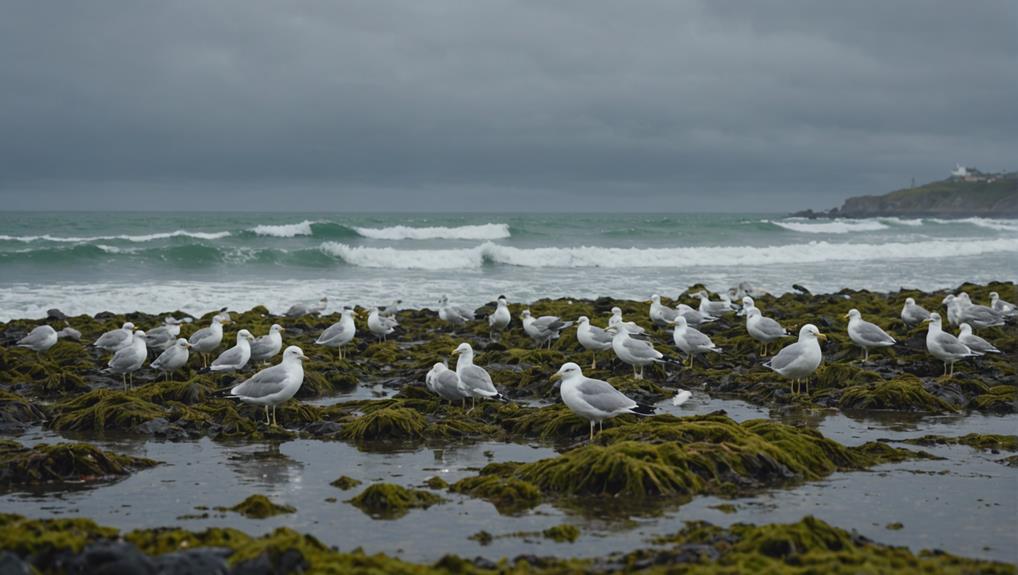Seagulls live by the sea because it offers abundant food sources like fish, shellfish, and even human leftovers. Beaches provide ideal materials for nesting, such as seaweed and driftwood, and the coastal environment guarantees their chicks have a steady food supply. Moreover, the sea acts as a natural barrier, protecting them from many land-based predators. The shorelines are rich hunting grounds, filled with diverse marine life that supports their dietary needs. Moreover, seagulls benefit from scavenging opportunities, like washed-up marine creatures and beach litter. The coastal habitat serves them well in numerous ways—uncovering these layers reveals more fascinating details.
Abundant Food Sources
Seagulls are naturally drawn to coastal areas due to the abundance of food sources such as washed-up shellfish, dead animals, ragworms, and small fish. These coastal habitats offer an ideal environment for gulls, providing a constant and diverse supply of nourishment.
Beaches, in particular, are rich in food options, from marine life to human leftovers like litter, spills, and crumbs. For seagulls, these easily accessible food sources make coastal areas prime locations for feeding.
The feeding patterns of gulls are heavily influenced by the availability of these resources. When beaches are not regularly cleaned, they become even more attractive to seagulls. Uncollected debris and natural detritus like dead animals and washed-up shellfish provide ample feeding opportunities.
This abundance makes coastal areas not just suitable but crucial habitats for seagulls, ensuring their survival and allowing them to thrive.
Interestingly, even gull species that spend time away from the sea are drawn back to coastal regions by the promise of abundant food. Whether scavenging for ragworms or small fish, seagulls rely on the rich food sources provided by these environments, highlighting the critical role that coastal areas play in their daily lives.
Ideal Nesting Grounds
Coastal areas offer ideal nesting grounds for seagulls due to their diverse nesting materials, protection from predators, and proximity to abundant food sources. These environments are specifically suited to the needs of seagulls in terms of breeding and raising their young.
The availability of open spaces allows seagulls to easily spot potential threats, while the proximity to the sea guarantees a constant supply of food sources such as fish, shellfish, and marine invertebrates.
Seagulls choose coastal areas for several reasons:
- Abundant nesting materials: Beaches provide a range of materials like seaweed and driftwood that seagulls use to build their nests.
- Access to diverse food sources: The coastal environment ensures a steady supply of food, from washed-up debris to small fish and dead animals.
- Suitable breeding conditions: The mild climate and open spaces offer an ideal setting for seagulls to lay eggs and raise their chicks.
These factors contribute significantly to why seagulls prefer coastal areas as their nesting grounds.
The combination of safety, abundant food, and suitable materials creates an excellent habitat where seagulls can thrive. This intricate balance of conditions ensures that seagulls continue to populate and flourish in these regions.
Protection From Predators

The vast expanse of the sea takes advantage of its formidable natural barrier, offering seagulls significant protection from terrestrial predators. This vast water body acts like a moat around a castle, keeping many land-based threats at bay. Predators such as foxes, raccoons, and other mammals are less likely to venture into the water, providing seagulls with a safer environment to roost and nest.
By living near the sea, seagulls utilize this natural barrier to their advantage. The open sea not only reduces the risk of predation but also offers them easy escape routes. In case of an approaching threat, seagulls can swiftly take flight over the water, where few predators can follow. This strategic use of the sea provides them with an added layer of security that is less accessible to birds living inland.
Moreover, the coastal environment allows seagulls to nest on cliffs, islands, and secluded beaches, further minimizing exposure to potential dangers. These nesting sites are often inaccessible to many predators, ensuring that seagulls can raise their young in relative safety.
The combination of these factors makes the sea an ideal habitat, offering seagulls robust protection from predators.
Suitable Hunting Environment
Due to the rich and diverse food sources available, marine environments provide seagulls with an ideal hunting ground. The coastal regions are particularly advantageous for these birds, offering a wide range of dietary options that are not as easily found inland. Seagulls, including those that are the state bird of Utah, often rely on the plentiful marine life that thrives in these habitats.
Seagulls' hunting success in coastal areas is made possible by several factors:
- Abundant Marine Life: Fish, shellfish, and marine invertebrates are readily available, ensuring that seagulls have a consistent food supply.
- Shoreline Accessibility: The ebb and flow of tides wash up a variety of food items such as dead animals and small fish, making it easy for seagulls to find nourishment.
- Adaptive Feeding Techniques: Seagulls are skilled at exploiting different food sources, from diving for fish to picking at washed-up remains or even following fishing boats for discards.
The coastal environment not only supports their dietary needs but also boosts their hunting efficiency. This mix of natural abundance and accessible food sources underscores why seagulls thrive in marine settings.
Natural Scavenging Opportunities

Apart from their hunting prowess, seagulls capitalize on diverse scavenging opportunities provided by the coastal environment. Coastal areas, particularly beaches, present a plethora of food sources, making them ideal habitats for these resourceful birds. Seagulls are adept at finding nourishment in the form of washed-up shellfish, dead animals, and small fish, which are frequently found along the shoreline. These essential scavenging opportunities are crucial for seagulls' survival, as they supplement their diet when active hunting is less fruitful.
Beaches, especially those that are less frequently cleaned, offer an abundance of food. Seagulls can often be seen picking at litter, discarded crumbs, and even the remnants left by beachgoers. Spilled food and scraps from picnics provide additional sustenance. Moreover, the beach environment supports different invertebrates such as ragworms, which seagulls eagerly consume.
While some gull species occasionally venture inland, they are naturally drawn back to coastal areas where the availability of food is more predictable. The dynamic interplay of tides and human activities continuously replenishes these scavenging opportunities, ensuring that seagulls thrive by the sea.
Therefore, the beach environment plays a vital role in supporting the scavenging lifestyle of seagulls.
Frequently Asked Questions
Why Do Seagulls Live Near the Water?
Seagulls live near the water because it provides them with abundant food sources and an ideal habitat. Coastal areas offer washed-up shellfish, dead animals, and small fish, which are essential for their diet.
Moreover, seagulls are opportunistic scavengers, thriving in environments where food is readily available. Their natural adaptation to coastal life allows them to efficiently exploit these resources, making the water's edge their perfect home.
Do Seagulls Always Live by the Sea?
Seagulls do not always live by the sea. Many species have adapted to diverse environments, including lakes, rivers, and urban areas, far from the coast.
For instance, the California Gull thrives in both urban settings and human settlements. Their adaptability allows them to exploit different food sources and habitats, demonstrating their wide geographic distribution and versatility.
Consequently, seagulls can be found in numerous locations beyond just coastal regions.
Why Are There so Many Seagulls at the Beach?
Seagulls are abundant at the beach due to the rich availability of food sources. Beaches provide washed-up shellfish, dead animals, and small fish, which are crucial for their diet.
Furthermore, gulls scavenge for food left by people, such as litter and crumbs. This consistent and plentiful food supply makes beaches an ideal habitat.
The diverse feeding opportunities at the beach sustain their thriving populations, attracting numerous seagulls.
How Do Seagulls Survive at Sea?
Seagulls survive at sea thanks to several unique adaptations. Their specialized exocrine glands enable them to drink salt water, while their diverse diet includes fish, shellfish, and marine invertebrates.
Moreover, seagulls exhibit opportunistic feeding behaviors, scavenging both natural and human-created food sources. Coastal areas provide crucial nesting sites and protection from predators, ensuring their ability to breed and thrive.
These adaptations allow seagulls to flourish in marine environments.

